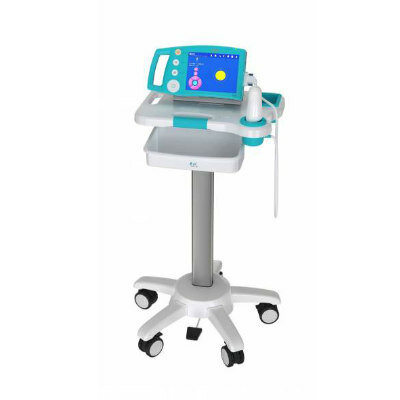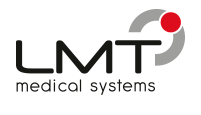CT Analysis Algorithms Highly Accurate in COVID-19 Detection 
|
By MedImaging International staff writers Posted on 12 May 2020 |

Image: AI can aid radiologists rapidly detect COVID-19 (Photo courtesy of RADLogics)
A novel artificial intelligence (AI) algorithm supports chest computed tomography (CT) imaging for COVID-19 patients.
The RADLogics (Tel Aviv, Israel) algorithms apply machine learning image analysis and interpretation to automatically detect, quantify, and track COVID-19 via non-contrast thoracic CT exams. The AI-based image analysis outputs a suggested “corona score” in order to measure progression of a patients’ disease. For time analysis, the algorithm measures smaller opacities and visualizes larger opacities in a slice-based heat map or in a three dimensional (3D) volume display. The algorithms are easily integrated in both in-house and via a workflow platform that uses Amazon Web Services (AWS) to process up to one million CT studies per day.
In a study involving 157 patients with and without COVID-19 at Mount Sinai Health System (New York, NY, USA) and other institutions, the CT image analysis algorithms, developed from multiple international datasets, were able to differentiate COVID-19 with 98.2% sensitivity and 92.2% specificity. According to the researchers, rapidly screening and evaluating high volumes of thoracic CT imaging studies can assist healthcare systems by augmenting radiologists and acute care teams that could be overwhelmed with patients.
“We’ve seen incredibly strong demand from healthcare systems and providers around the world. Our system has enabled these hospitals to enhance their ability to manage symptomatic patients, especially those with severe or worsening respiratory status,” said Moshe Becker, CEO and co-founder of RADLogics. “Our solution improves patient care by providing doctors with a ‘Corona Score’ that provides clinicians automatic measurements of disease extent of COVID-19 patients, allowing doctors to better manage a patient’s treatment.”
“Current epidemics are calling for new healthcare management approaches, and effective clinical management depends more on disease severity than on the virus identification,” said Sergey Morozov, MD, PhD, MPH, CEO of the Moscow Diagnostics and Telemedicine Center (Russia). “We are looking forward to integrating RADLogics’ AI-powered solution across our hospital network throughout Moscow where imaging plays a crucial role in patient management, specifically chest CT. It allows defining symptomatic patients and stratifying them into mild, moderate, and severe disease burden groups.”
COVID-19 typically manifests with bilateral ground-glass and consolidative pulmonary opacities on CT. Nodular opacities, crazy-paving pattern, and a peripheral distribution of disease may be additional features helpful in early diagnosis. On the other hand, lung cavitation, discrete pulmonary nodules, pleural effusions, and lymphadenopathy are characteristically absent.
Related Links:
RADLogics
The RADLogics (Tel Aviv, Israel) algorithms apply machine learning image analysis and interpretation to automatically detect, quantify, and track COVID-19 via non-contrast thoracic CT exams. The AI-based image analysis outputs a suggested “corona score” in order to measure progression of a patients’ disease. For time analysis, the algorithm measures smaller opacities and visualizes larger opacities in a slice-based heat map or in a three dimensional (3D) volume display. The algorithms are easily integrated in both in-house and via a workflow platform that uses Amazon Web Services (AWS) to process up to one million CT studies per day.
In a study involving 157 patients with and without COVID-19 at Mount Sinai Health System (New York, NY, USA) and other institutions, the CT image analysis algorithms, developed from multiple international datasets, were able to differentiate COVID-19 with 98.2% sensitivity and 92.2% specificity. According to the researchers, rapidly screening and evaluating high volumes of thoracic CT imaging studies can assist healthcare systems by augmenting radiologists and acute care teams that could be overwhelmed with patients.
“We’ve seen incredibly strong demand from healthcare systems and providers around the world. Our system has enabled these hospitals to enhance their ability to manage symptomatic patients, especially those with severe or worsening respiratory status,” said Moshe Becker, CEO and co-founder of RADLogics. “Our solution improves patient care by providing doctors with a ‘Corona Score’ that provides clinicians automatic measurements of disease extent of COVID-19 patients, allowing doctors to better manage a patient’s treatment.”
“Current epidemics are calling for new healthcare management approaches, and effective clinical management depends more on disease severity than on the virus identification,” said Sergey Morozov, MD, PhD, MPH, CEO of the Moscow Diagnostics and Telemedicine Center (Russia). “We are looking forward to integrating RADLogics’ AI-powered solution across our hospital network throughout Moscow where imaging plays a crucial role in patient management, specifically chest CT. It allows defining symptomatic patients and stratifying them into mild, moderate, and severe disease burden groups.”
COVID-19 typically manifests with bilateral ground-glass and consolidative pulmonary opacities on CT. Nodular opacities, crazy-paving pattern, and a peripheral distribution of disease may be additional features helpful in early diagnosis. On the other hand, lung cavitation, discrete pulmonary nodules, pleural effusions, and lymphadenopathy are characteristically absent.
Related Links:
RADLogics
Latest General/Advanced Imaging News
- New AI Method Captures Uncertainty in Medical Images
- CT Coronary Angiography Reduces Need for Invasive Tests to Diagnose Coronary Artery Disease
- Novel Blood Test Could Reduce Need for PET Imaging of Patients with Alzheimer’s
- CT-Based Deep Learning Algorithm Accurately Differentiates Benign From Malignant Vertebral Fractures
- Minimally Invasive Procedure Could Help Patients Avoid Thyroid Surgery
- Self-Driving Mobile C-Arm Reduces Imaging Time during Surgery
- AR Application Turns Medical Scans Into Holograms for Assistance in Surgical Planning
- Imaging Technology Provides Ground-Breaking New Approach for Diagnosing and Treating Bowel Cancer
- CT Coronary Calcium Scoring Predicts Heart Attacks and Strokes
- AI Model Detects 90% of Lymphatic Cancer Cases from PET and CT Images
- Breakthrough Technology Revolutionizes Breast Imaging
- State-Of-The-Art System Enhances Accuracy of Image-Guided Diagnostic and Interventional Procedures
- Catheter-Based Device with New Cardiovascular Imaging Approach Offers Unprecedented View of Dangerous Plaques
- AI Model Draws Maps to Accurately Identify Tumors and Diseases in Medical Images
- AI-Enabled CT System Provides More Accurate and Reliable Imaging Results
- Routine Chest CT Exams Can Identify Patients at Risk for Cardiovascular Disease
Channels
Radiography
view channel
Novel Breast Imaging System Proves As Effective As Mammography
Breast cancer remains the most frequently diagnosed cancer among women. It is projected that one in eight women will be diagnosed with breast cancer during her lifetime, and one in 42 women who turn 50... Read more
AI Assistance Improves Breast-Cancer Screening by Reducing False Positives
Radiologists typically detect one case of cancer for every 200 mammograms reviewed. However, these evaluations often result in false positives, leading to unnecessary patient recalls for additional testing,... Read moreMRI
view channel
PET/MRI Improves Diagnostic Accuracy for Prostate Cancer Patients
The Prostate Imaging Reporting and Data System (PI-RADS) is a five-point scale to assess potential prostate cancer in MR images. PI-RADS category 3 which offers an unclear suggestion of clinically significant... Read more
Next Generation MR-Guided Focused Ultrasound Ushers In Future of Incisionless Neurosurgery
Essential tremor, often called familial, idiopathic, or benign tremor, leads to uncontrollable shaking that significantly affects a person’s life. When traditional medications do not alleviate symptoms,... Read more
Two-Part MRI Scan Detects Prostate Cancer More Quickly without Compromising Diagnostic Quality
Prostate cancer ranks as the most prevalent cancer among men. Over the last decade, the introduction of MRI scans has significantly transformed the diagnosis process, marking the most substantial advancement... Read moreUltrasound
view channel
Deep Learning Advances Super-Resolution Ultrasound Imaging
Ultrasound localization microscopy (ULM) is an advanced imaging technique that offers high-resolution visualization of microvascular structures. It employs microbubbles, FDA-approved contrast agents, injected... Read more
Novel Ultrasound-Launched Targeted Nanoparticle Eliminates Biofilm and Bacterial Infection
Biofilms, formed by bacteria aggregating into dense communities for protection against harsh environmental conditions, are a significant contributor to various infectious diseases. Biofilms frequently... Read moreNuclear Medicine
view channel
New SPECT/CT Technique Could Change Imaging Practices and Increase Patient Access
The development of lead-212 (212Pb)-PSMA–based targeted alpha therapy (TAT) is garnering significant interest in treating patients with metastatic castration-resistant prostate cancer. The imaging of 212Pb,... Read moreNew Radiotheranostic System Detects and Treats Ovarian Cancer Noninvasively
Ovarian cancer is the most lethal gynecological cancer, with less than a 30% five-year survival rate for those diagnosed in late stages. Despite surgery and platinum-based chemotherapy being the standard... Read more
AI System Automatically and Reliably Detects Cardiac Amyloidosis Using Scintigraphy Imaging
Cardiac amyloidosis, a condition characterized by the buildup of abnormal protein deposits (amyloids) in the heart muscle, severely affects heart function and can lead to heart failure or death without... Read moreImaging IT
view channel
New Google Cloud Medical Imaging Suite Makes Imaging Healthcare Data More Accessible
Medical imaging is a critical tool used to diagnose patients, and there are billions of medical images scanned globally each year. Imaging data accounts for about 90% of all healthcare data1 and, until... Read more
Global AI in Medical Diagnostics Market to Be Driven by Demand for Image Recognition in Radiology
The global artificial intelligence (AI) in medical diagnostics market is expanding with early disease detection being one of its key applications and image recognition becoming a compelling consumer proposition... Read moreIndustry News
view channel
Bayer and Google Partner on New AI Product for Radiologists
Medical imaging data comprises around 90% of all healthcare data, and it is a highly complex and rich clinical data modality and serves as a vital tool for diagnosing patients. Each year, billions of medical... Read more





















